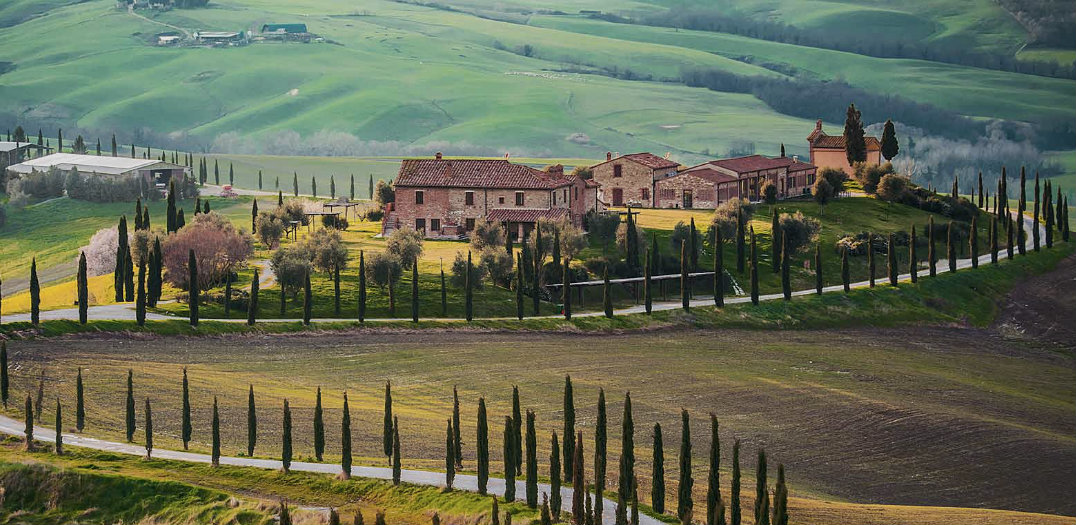
Tuscany is one of the most prestigious wine-growing regions in the world. Home of Sangiovese, it is traditionally known for its Chianti and Brunello di Montalcino located inland on the hills. However, the coastal areas are catching up, with Bolgheri and Maremma now perceived as rising stars within the region.
Tuscany’s Wine History
Winemaking in Tuscany dates back to the 8th century BC when the Etruscans imported grapes from the Middle East. The region was later annexed by the Greeks who named it ‘Enotris’ meaning ‘the land of wine’ before the Romains took over, reverting to the Estruscan name ‘Tuscany’. During the Middle Ages, the Benedictine monks continued the viticultural tradition and systematically planted vines around churches, however, given the small production the wines remained in the region.
Wine production really took off during the Rennaissance with the first bottle known to be sold outside Tuscany in 1710. Chianti benefited from the trade with great success and received the first legally enforced example of a DOC (meaning designation of origin – which is a legally defined wine-growing region) six years later. Tuscany has continued to flourish over the centuries with wine production expanding to the coastal area in the 1970s. Today there are 41 DOC and 11 DOCG (Denominazione d’Origine Controllata e Garantita).
Climate & Soil
Tuscany lies in central Italy along the Tyrrhenian coast and back up into the foothills of the Apennines. Predominantly a hilly region, about 25% of the landscape is mountainous with just 8% considered flat.
Inland, the climate is Mediterranean with hot and dry summers. The soils are composed of a mixture of clay and limestone, perfectly suited to grow Tuscany’s most famous grape variety – Sangiovese. This grape variety thrives on the hillside of Chianti, between Florence and Siena, as well as in Montalcino and Montepulciano, where it is respectively known as Brunello and Prugnolo Gentile.
Towards the coast, soils are characterised by gravel and sand. The climate is cooler and wetter due to the influence of the sea. Here, Cabernet Sauvignon works wonders alongside other international grape varieties including Merlot, Syrah and Sauvignon Blanc.
Tuscany’s Wine Style
Mainly reds are produced with Sangiovese accounting for two-thirds of all plantings however, there are plenty more varieties and styles to discover.
BROWSE OUR SELECTION FROM TUSCANY
Chianti
Originally served in a straw-wrapped wine bottle, Chianti was the first area to be legally protected. Mainly made with Sangiovese, the wines are usually blended with grape varieties Canaiolo and Colorino and more recently Cabernet Sauvignon and Merlot. The best examples are found within the Classico DOCG. Premium wines are labelled as Riserva and recently Gran Selezione (requiring 30 months ageing minimum). Another one to look at is Chianti Rufina DOCG.
The legend of Chianti Classico’s seal – all bottles are sealed with a small label displaying a black rooster started in the 13th century, when Florence and Siena decided to use a horse race to end their land dispute over Chianti. The meeting point of two knights, who had left each town when the rooster sang at dawn, would mark the new borders of their territories. It has remained the seal of the region ever since.
Brunello di Montalcino
Located south of Sienna, Brunello is known as one of the most age-worthy wines. Meaning ‘the little dark one’, the wine is named after the local Sangiovese clone which has thicker-skinned berries and produces wines with exceptionally concentrated fruit, high tannins, and high acidity. The rules of the region (DOCG) dictate that the wine must be made with 100% Sangiovese, aged for at least 24 months in oak barrels and must not be released until the beginning of the fifth year following the harvest. Its little brother Rosso di Montalcino can be enjoyed in its youth and is available for a fraction of the price.
Vino Nobile & Vin Santo di Montepulciano
Further inland is the town of Montepulciano (not to be confused with the grape predominantly found in the Abruzzo region) which produces the powerful and complex Vino Nobile di Montepulciano. Made with a minimum of 70% Sangiovese, locally known as Prugnolo Gentile, it can be blended with Mammolo, Canaiolo and Malvasia. Vino Nobile must be aged for 24 months (36 months for Riserva). Rosso di Montepulciano are less concentrated and made for earlier consumption.
The region is also home to Vin Santo, a sweet wine made with Trebbiano and Malvasia. The grapes are hung on roof beams and dried before being pressed to concentrate the sugar. The wine is matured for at least three years in small oak barrels and is known for its almond flavours.
Bolgheri & ‘Super Tuscans’
In the 1970s, some winemakers that were frustrated with the restrictive DOC rules, started to experiment in the coastal area of Bolgheri with non-local grape varieties. Due to the climate and soils, Bordeaux grapes were favoured. The iconic wine Sassicaia made by Tenuta San Guido was the first wine ever made here with Cabernet Sauvignon, giving Bolgheri its own DOC status two decades later. Following this success other wineries including Antinori and Tenuta dell Ornellaia acquired land and planted vines in the region. A blend of local and international varieties, the wines proved particularly successful in America and became known as ‘Super Tuscans’.
Maremma
Elsewhere in the south, the up-and-coming coastal area of Maremma enjoys a cooler climate perfect for growing early-ripening grape such as Sauvignon Blanc, Pinot Noir and local Ciliegiolo. Meaning ‘small cherry’ in Italian, Ciliegiolo produces elegant and beautifully fragranced reds. Being a new winemaking area, the rules are not as tight as other regions. As a result, Maremma is also a great source of white Vermentino alongside rosé and sparkling wines made with Sangiovese.

